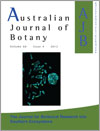Australian Journal of Botany
Volume 60
Number 4 2012
Breakage of macadamia kernels into halves (cotyledons) is an important cultural issue. Electron microscopy revealed a relationship between kernel breakage and the surface morphology of its inner cuticle. Naturally occurring gaps between kernel halves were measured and gap width and gap length were positively related to kernel breakage.
Peltate glands occur on aerial vegetative organs of Centrolobium tomentosum, mainly on the leaves. These glands show an unusual structure and produce terpenic resin, which appears to be a great potential for plant protection. For the first time these structures were studied by electron microscopy and the secretion composition was determined.
Glasshouse experiments assessed growth of the weed Lippia (Phyla canescens) following damage to whole plants and plant pieces. Plants recovered from damage through growth from stem nodes. The most effective biological agents will be those that limit lippia’s vegetative growth and spread, such as shoot- or crown-feeding insects.
Predominant regeneration modes, sprouting versus non-sprouting, will result in contrasting evolutionary and ecological responses that may be traced by nuclear markers. We compared pairwise genetic patterns of the predominant sprouter N. antarctica with the mainly non-sprouter N. pumilio along their geographically concordant widespread range. The sprouter N. antarctica showed higher genetic variation than did the non-sprouter N. pumilio; therefore, predominantly sprouting, as compared with mainly non-sprouting, has favoured long-term persistence of genetic variants in relatively large populations.
Seedling survivorship is crucial to population maintenance, particularly in frequently disturbed communities like grasslands. Using previously established relationships, we found that reducing rainfall by up to 40% had only slight impacts on modelled seedling survivorship of perennial species from temperate grasslands. Thus, these species appear robust to changes in rainfall.
We assessed the laboratory germination responses of 20 annual forbs from semiarid grasslands and found that rapid, synchronous germination is their main strategy. Germination lag and speed better explained predominantly transient seed-banks than percentage germination in light or dark.
Fire drives the population dynamics of many plant species adapted to pyrogenic ecosystems. We followed the lifetime demography of successive cohorts of Polygala lewtonii, a short-lived herb endemic to fire-maintained Florida sandhills, in both burned and unburned microsites. In burned microsites, higher seedling recruitment and survival, earlier flowering and longer lifespans combined to produce a greater contribution to the seedbank and thus to the long-term viability of the population.
A eucalypt hybrid outlasts its parental species growing on the same harsh salt- and drought-affected Chowilla floodplain in South Australia. The hybrid, called green box had specific leaf area and leaf nitrogen significantly lower compared with the parental species, E. largiflorens F.Muell (black box). These leaf-structure characteristics indicated reduced growth potential, conserving resources, and illustrated a useful strategy to consider when choosing plants for revegetation efforts.
Two contrasting strategies seem to underlie Gleditsia triacanthos success in Argentinean Chaco woodlands. The invasive tree might benefit by being similar to the dominant native, Prosopis alba, in regenerative features (i.e. recruitment), but differing in its combination of attributes that enhance competitive ability (i.e. persistence and eventually dominance).
Detailed karyotype analysis was performed on the palm tree Trithrinax campestris (Arecaceae). The species displayed a karyotype with 2n = 36, a genome size (2C = 17.15 ± 0.07 pg) exceptionally high for a palm tree, and an elevated heterochromatin amount (39%). Amplification of satellite DNA probably played an important role in its karyotype evolution




